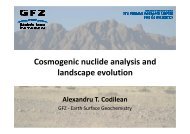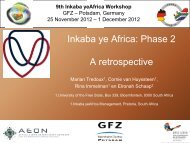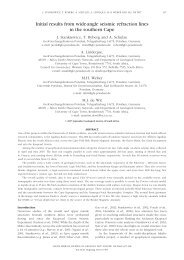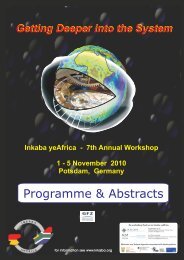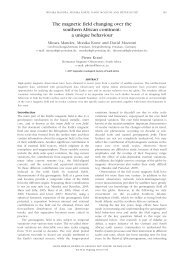South Africa - Inkaba.org
South Africa - Inkaba.org
South Africa - Inkaba.org
Create successful ePaper yourself
Turn your PDF publications into a flip-book with our unique Google optimized e-Paper software.
Fate of soil <strong>org</strong>anic matter in <strong>South</strong> <strong>Africa</strong>n crop and pasture<br />
land<br />
C.C. du Preez 1 , W. Amelung 2<br />
1. Department of Soil, Crop and Climate Sciences, University of the Free State, P O Box 339,<br />
Bloemfontein 9300, Republic of <strong>South</strong> <strong>Africa</strong>, dpreezcc@ufs.ac.za<br />
2. Department of Soil Science and Soil Ecology, Rheinische Friedrich-Wilhelms-Universität Bonn,<br />
Nussallee 13, Bonn, Germany, wulf.amelung@uni-bonn.de<br />
ABSTRACT<br />
Organic matter influences properties of mineral soils disproportionately to the quantities present. It is thus not<br />
surprising that <strong>org</strong>anic matter is regarded as the most important indicator of soil quality and health. Soil with good<br />
quality and health usually promotes sustainable land use in agriculture. A proper knowledge on the fate of <strong>org</strong>anic<br />
matter in agricultural soils is therefore essential in the design of management practices enhancing sustainable land<br />
use. Several studies were conducted over the past 10 years to establish the fate of <strong>org</strong>anic matter in <strong>South</strong> <strong>Africa</strong>n<br />
crop (0-98 years old) and pasture (0-31 years old) land. These studies were done in three agro-ecosystems<br />
dominated by plinthic soils (clay ~ 14%), namely Harrismith (MAP ~ 625 mm and MAT ~ 13.8°C), Kroonstad<br />
(MAP ~ 563 mm and MAT ~ 16.6°C), and Tweespruit (MAP ~ 516 mm and MAT ~ 15.9°C). Representative soil<br />
samples were collected for analyses. The concentrations of <strong>org</strong>anic carbon and nitrogen were determined in bulk<br />
soil, particle size separates, and water-stable aggregate classes. In addition, lignin derived phenols and amino<br />
sugars as markers for plant and microbial residues were measured. Long-term cultivation of native grassland<br />
reduced <strong>org</strong>anic matter in bulk soil by 60%, reaching equilibrium after 30 years. Losses of <strong>org</strong>anic matter occurred<br />
from all particle sizes, with increasing rates as particle size increased. Aggregates decreased in size into finer<br />
classes. However, <strong>org</strong>anic matter contents decreased in all aggregate classes, but fastest in the 2.8 to 8.0 mm class.<br />
Increased ratios of phenolic acids to aldehydes suggested that side chains were increasingly oxidized. Amino sugar<br />
analyses suggested that fungal residues were better preserved than bacterial residues, while microbial residues<br />
declined by 60%. It appears that these losses and changes in <strong>org</strong>anic matter cannot easily be rectified by the<br />
conversion of crop to pasture land.<br />
KEYWORDS: aggregate size, amino sugar, microbial residue, phenolic aldehyde<br />
23



